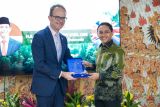Jakarta (ANTARA) - Climate change has brought a range of meteorological problems to the beloved planet Earth, threatening countries around the globe, including Indonesia, with a potential food crisis.
This unfavorable trend has put talks about food resilience under the international community’s spotlight. This reality has made several regions across Indonesia face the threat of drought, which, in turn, might adversely affect the stocks of people’s staple food commodities.
Indonesia requires more significant measures against drought-induced food shortage in its urban regions that lack agricultural areas, especially its current capital city, Jakarta, which is home to around 10.6 million people, according to data in 2023.
Due to the city’s limited agricultural area, the Jakarta provincial government has taken initiatives to help the seat of government achieve food self-sufficiency, including by intensively promoting urban agriculture practices.
Such practices have been promoted by the government and people, such as Epon Sukarsih, 54, a resident of Duren Sawit, East Jakarta, who has been working creatively to turn her surroundings into a crop-producing spot.
Since mid-May, Epon has been cultivating paddies on the bank of the East Flood Canal (BKT), using rice seeds obtained from online shops.
Growing rice in BKT
The BKT, whose development began in November 2003, has seen its functions expand beyond a flood-control facility, becoming an appealing spot for residents to spend their free time on the weekends.
People tend to visit the BKT area to do some low-intensity exercises, such as jogging, cycling, or simply walking, while some others choose the area as a playground for their kids while enjoying various street foods offered by nearby vendors.
On the other side of the 100-meter-wide canal, Epon was seen drying up the paddies cut by her niece, Ujang, who came from her hometown of Sumedang, West Java, solely to help her manage her urban rice field.
Due to her advanced age and the health problems she has been grappling with, independently managing the farm's yields has grown too taxing for the mother of two.
At first, the idea of cultivating rice in the BKT area had never crossed her mind. She formerly opted to grow timun suri, a melon-like cucumber native to Indonesia, as she found its cultivation to be much simpler and less costly.
The problem is that timun suri tends to be popular among Indonesians only during the fasting month of Ramadan.
The granny of two then shifted to rice farming, contemplating on using the paddy’s straw and chaff as feed for Qurbani livestock, which would be sacrificed during Eid al-Adha, and reserving the rice output for personal consumption.
For some reason, though, Epon could not plant the rice seeds she had prepared on time. As a result, the rice would not be ready for harvest until September, while on the other hand, this year’s Eid al-Adha fell in June. She had to scrap her plan B as well.
Refusing not to let the rice seeds she obtained online go to waste, Epon decided to plant them on her urban farming plot, spanning 70 meters in length and 6 meters in width.
Epon, a mobile vegetable vendor, has been involved in every process taking place on her urban farm, investing both financially and personally.
She spent money on seeds, fertilizers, watering equipment, protective nets, and workers who would dig up the soil and water the paddies. Moreover, she has dedicated a chunk of her valuable time to protecting her crops from likely bird invasions.
All her efforts helped Jakarta transform its BKT area into a greener space. She has demonstrated that rice can grow in Jakarta, a metropolitan bustling with skyscrapers.
In fact, her urban farm has been frequently visited by students from a school in East Jakarta, acting as a medium of agricultural education.
“This might be the first and last time I plant rice. I will just grow chilies or timun suri next time,” she told ANTARA with a laugh.
A green space
Epon is not the only resident seizing the agricultural opportunities presented by the BKT area. Various plants have been planted along the banks of the flood canal stretching across 11 urban villages in East Jakarta.
The BKT spans 23.5 kilometers in length, cutting through the rivers of Cipinang, Sunter, Buaran, Jatikramat, and Cakung.
The greening of the BKT area has been the result of the Jakarta government’s Fruit Village Program, which has moved local residents to polish the area with trees of mango, avocado, papaya, banana, and melon, as well as grape.
Apart from the varied fruits, locals are cultivating a range of vegetables in the flood canal area, including tomatoes, Chinese cabbages, cassavas, corn, chilies, and eggplants for sale or household consumption.
Baca juga: Indonesia pertama di festival kuliner "Belt and Road"
Baca juga: Indonesia shares food security practices with African nations
Since the kick-off of the Fruit Village program in 2021, the East Jakarta Office of Food Resilience, Marine Affairs, and Agriculture has been directing the program to focus on the BKT area, spanning 20 thousand square meters in the south and 10 thousand square meters in the north across the sub-districts of Duren Sawit, Jatinegara, and Cakung.
Proper, effective management of the BKT banks as agricultural spots could help local people meet their needs for vegetables and fruits independently, ultimately assisting the government in building food resilience in anticipation of a climate change-induced food crisis.










